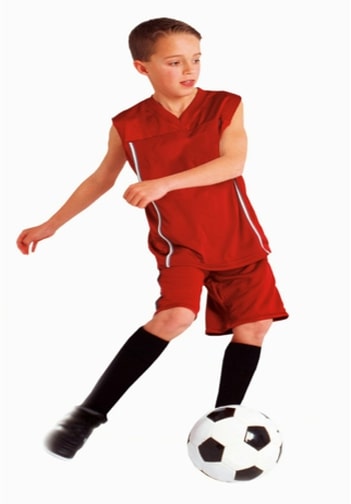
The tibial tuberosity is the area of the shin where the quadriceps muscle attaches below the knee cap. When a child has Osgood Schlatter’s syndrome the growth plate of this attachment becomes inflamed from overuse rather than a traumatic injury.
What Causes Osgood Schlatter’s Syndrome
Osgood Schlatter’s is caused by repetitive tractioning of the quadriceps muscle as it pulls on it’s attachment to the shin. In children this attachment is still made of cartilage (growth plate). Continued pulling on the attachment causes the body to try to reinforce the area and build more bone to make it stronger resulting in the characteristic lumpy or knobbly knees.
Another cause of Osgood Schlatter’s is tight quadriceps muscles caused by a slower growth of the muscles relative to the femur or thigh bone. This form of the syndrome usually occurs during a growth spurt when the muscle is unable to keep up with the rapid bone growth.
How Will I know If My Child Has Osgood Schlatter’s?
You might suspect Osgood Schlatters if your child complains of any of the following:
- Local pain, swelling and tenderness over the tibial tuberosity under the kneecap
- Pain with exercise (running, jumping) or with contact to the knee
- Pain with up and down stairs, squatting and kneeling
- Weak quadriceps muscles (after pain has been present for a long time)
- In the later stages or when pain has been present for a long time your child might have a tender lump on the top of the shin under the kneecap
- In 20-30% of cases of Osgood Schlatter’ your child may have pain in both knees.
Osgood Schlatters usually strikes active adolescents in periods of rapid growth. Boys are usually affected more than girls, however either gender can suffer from Osgood Schlatters. Boys are usually affected at a slightly later age than girls (Boys 11-15years, Girls 8-13years) corresponding to the times for maximum growth in each gender.
The sports and activities where Osgood Schlatters is commonly found are:
- Athletics (Running and Jumping)
- Volleyball
- Basketball
- Soccer
- Gymnastics
- Dance Netball
- Skating/Scooter/Skateboarding
Most of the time investigations aren’t needed for Osgood Schlatters Syndrome. In some cases your Doctor or Physio might send your child for xrays to rule out any other causes of knee pain. MRI investigations aren’t necessary to diagnose Osgood Schlatters.
My Child Has Osgood Schlatters, Now What?
A mild case of Osgood Schlatters Syndrome may resolve within a few days with rest from aggravating activities, however you should arrange for your child to see a Physiotherapist or Doctor for professional assessment and management as severe and longstanding Osgood Schlatters can result in an avulsion fracture of the patella tendon where the tibial tuberosity pulls of the shin bone.
Fortunately most cases of Osgood Schlatters can be well managed conservatively.
Treatment for Osgood Schlatters
Physiotherapy is the first line of treatment for Osgood Schlatters. 90% of children with Osgood Schlatters will respond to non-operative treatment with a Physio with recovery taking 12-24months where symptoms may flare and resolve at different times.
Your child’s Physio will recommend the following:
- Stopping high impact activities and sports with running and jumping
- Use of taping or a brace/strap worn under the knee cap to reduce the forces pulling on the muscle attachment
- Some Physios may use Kinesiotape to help to give pain relief and reduce the pull of the muscle on the shin
- In some very rare cases the Physio may recommend your child uses crutches
- Anti-inflammatory measures such as applying ice packs to the front of the knee
- Your child may need to wear arch supports or orthotics if their foot positioning is causing additional unusual forces on the shin
Exercise Program
Your child’s Physio will also prescribe specific exercises to help reduce the tightness in your quadriceps muscles and to strengthen the muscles that control around the knee. Even though the quadriceps muscles are tight, stretches aren’t usually prescribed as they can tension and irritate the growth plate on the shin.
Prognosis
Although your child’s symptoms may linger for some time, Osgood Schlatter’s syndrome will resolve with the closure of the growth plate when your child finishes growing. Your child may be left with an enlarged tibial tuberosity or bump on their shin which may cause discomfort with kneeling.
To make sure your child recovers as quickly as possible make an appointment with your Physiotherapist
